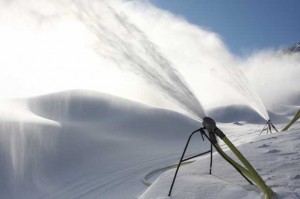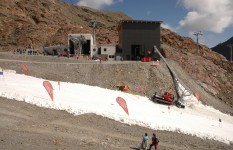
Snow gun in action
The winter of 1949-1950 was a bad snow year and the Tey Manufacturing Company of Milford Connecticut was having a bad year as well. Tey produced the ALU-60 which was an aluminum ski with a hollow core and arguably ahead of its time, but sales were way down due to the lack of snow. On March 14, 1950 Wayne Pierce who was one of the partners in the Tey company supposedly said “I know how to make snow!”
Using a spray paint compressor, garden hose, and nozzle, Pierce was able to successfully demonstrate his idea. His concept was the same we see today in a majority of snowmaking installations. By the following winter Pierce and Tey Manufacturing installed two test systems: one at Mohawk Mountain Ski Area in Cornwall, Conn., and one at Split Rock Lodge in the Poconos. One of the problems during the tests that had to be resolved was that the system produced a supersonic whistle, inaudible to humans but drove dogs crazy for miles around!
Bob DiMario and Dave Beach (both of Stowe) identified Mohawk Mountain as the first area with snowmaking in answer to last week’s trivia question. While that’s sort of correct, both of those initial installations were temporary, test systems.
As documented in the February, 1957 issue of Ski magazine the first full scale commercial snowmaking system was installed at Grossinger’s by Tey Manufacturing in 1952. The management of the New York ski area said that snowmaking “is no longer a luxury, but an absolute necessity for our winter operation.”

Snow fan gun in action
Which Vermont area first installed snowmaking is more difficult to determine. Walter Schoenknecht who ran Mohawk Mountain started Mount Snow in 1954 and it’s likely he would have added snowmaking as soon as he could. However Bill Jenkins who ran the Green Mountain College ski area in Poultney claims that the High Pond Ski Area located in Hubbardton was the first area in Vermont to install snowmaking possibly in 1952 or 1953. This claim has some credibility since High Pond was built and owned by W. Douglas Burden who developed Marinelands in Florida and California. Money was not a problem and in the 1940s and 1950s High Pond had the latest in equipment.
Mount Ascutney built its own snowmaking system from scratch in 1957. Killington came along in the winter of 1963-64. In 1966 Bromley made a huge investment of ¾ million dollars to cover the whole mountain and left its owner, Fred Pabst, wondering “whether this kind of expenditure can ever pay for itself.”
Stowe joined the parade in 1967 by adding snowmaking to the Little Spruce area. Surprisingly there were no correct answers to this part of last week’s trivia question.
With the exception of Killington most Vermont areas didn’t invest in expanding snowmaking until 1980. The winter of 1979-80 had been a particularly bad snow year and only two Vermont ski areas made money, one of them Killington. So in 1980 many areas including Stowe made significant investments to expand their snowmaking capabilities.

IDE snow maker in action
Now here we are in 2011 with vastly improved snowmaking capabilities, but lacking one important ingredient: cold temperatures! The Stowe Reporter editorial in the November 24th issue highlighted climatology data that show winters are warming up and getting shorter by approximately four days every decade. So what does the future hold?
While this column primarily looks at the past, let’s take a brief look into the future. IDE Technologies Ltd. markets a vacuum-based snowmaking system that can operate at any temperature. Even at 90 degrees Fahrenheit one IDE unit can crank out over 60,000 cubic feet of snow per day. At least two European areas already are using IDE systems.
The major drawback is that the snowmaking units are large requiring a building and hence operate from fixed locations. So getting the snow to where you want it becomes a challenge. However a unit at the base of Little Spruce could probably guarantee skiing on Easy Street and Inspiration for the 4th of July!

Leave a Reply